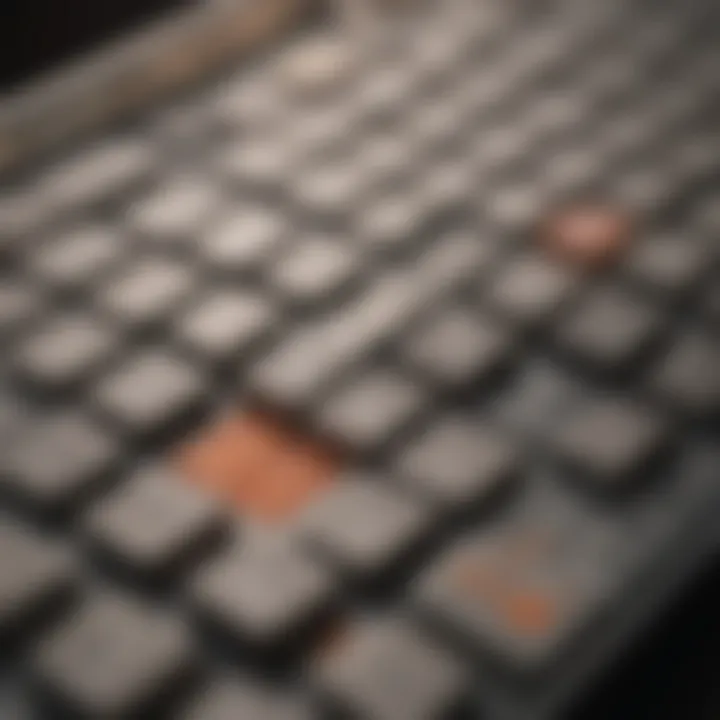Mastering Sudoku: Techniques and Strategies Explained


Intro
Sudoku, a logic-based number placement puzzle, has captured the attention of millions worldwide. It blends simplicity with profound complexity. As people engage with Sudoku, they often experience a range of challenges. This guide aims to clarify those challenges by presenting effective strategies. We will examine the fundamental aspects of Sudoku while also touching on advanced techniques suitable for skilled players.
Understanding the basic rules is essential for getting started. Each puzzle consists of a 9x9 grid divided into nine smaller 3x3 boxes. The objective is straightforward: fill the grid with numbers from one to nine. Each number can appear only once in each row, column, and 3x3 box. While the simplicity of the rules can be deceptive, the true challenge lies in the logic required to deduce the correct placements.
This article will unfold in a structured manner. First, we will discuss the foundational rules and terminology of Sudoku. Next, we will explore various techniques that can assist in solving puzzles. Finally, we will consider more advanced strategies that can enhance the skills of seasoned players.
"Sudoku is not just a game; it is a test of your logical thinking and problem-solving ability."
By following this guide, both beginners and experienced players can improve their Sudoku skills and deepen their understanding of the puzzles. In the sections that follow, we will provide detailed insights into solving techniques tailored to various skill levels.
Understanding Sudoku Fundamentals
Understanding the fundamentals of Sudoku is essential for anyone wanting to delve deeper into this logical puzzle. Grasping the basic concepts forms a solid foundation for tackling more complex strategies. Moreover, it helps players develop critical thinking and problem-solving skills. Sudoku is not just a game; it is a brain exercise that can enhance cognitive functions. Understanding its core principles is vital for both casual players and seasoned enthusiasts who seek to improve their skills.
What is Sudoku?
Sudoku is a logic-based number-placement puzzle. It typically consists of a 9x9 grid divided into nine 3x3 subgrids, known as boxes. The objective is clear: fill the entire grid with digits from 1 to 9. Every row, column, and box must contain all digits without repetition. This straightforward goal belies a complex layer of strategic thinking and deduction.
Basic Rules
To excel at Sudoku, familiarity with the basic rules is crucial. Each number can appear only once in each row, column, and box. This restriction creates a web of relationships that players must navigate to solve the puzzle. The numbers provided at the start serve as clues, guiding logical deductions. As players progress, they will learn to recognize patterns and use these rules to eliminate possibilities, leading to a solution.
Variations of Sudoku
Sudoku comes in various forms, catering to different skill levels and preferences. This section will explore a few prominent variants.
Standard Sudoku
Standard Sudoku is the traditional version most are familiar with. It features a grid of 9x9 with predefined numbers. The key characteristic of Standard Sudoku is its simplicity. This makes it accessible for new players and still challenging for advanced solvers. Its unique feature is the uniformity of rule application, which maintains consistency across different puzzles. This variant remains a beneficial choice for learners, allowing them to hone their techniques without overly complicated rules.
Diagonal Sudoku
Diagonal Sudoku introduces additional complexity by requiring digits to appear only once in each of the two main diagonals. This element significantly influences strategy, encouraging players to think more broadly about number placement. The charm of Diagonal Sudoku lies in its balance between challenge and traditional rules. While it can be confusing at first, it offers an enjoyable variation for those seeking a twist on the classic.
Hyper Sudoku
Hyper Sudoku expands upon the standard layout by adding extra constraints. In this variant, additional regions within the standard grid must also contain unique digits. This adds another layer of thinking, as players have to consider not just the rows, columns, and boxes but these new zones as well. Hyper Sudoku is advantageous for those looking to deepen their analytical skills. The challenge is rewarding for those who thrive on intense puzzle-solving.
Other Notable Variants
There are many other notable variants of Sudoku that cater to a wide array of preferences. These can include variations like Samurai Sudoku, where multiple grids overlap, or Sudoku with letters instead of numbers. Each variation introduces its specific set of rules and challenges. These differences allow for creativity and innovation in puzzle-solving, broadening the scope for enthusiasts. Engaging with these variants can provide fresh perspectives and enhance the overall Sudoku experience.
The Structure of Sudoku Puzzles
Understanding the structure of Sudoku puzzles is fundamental to solving them effectively. The framework of a Sudoku puzzle is not just about filling in numbers. It involves grasping the underlying principles that govern how the numbers interact within the grid. By being aware of how the puzzle is organized, solvers can make more informed decisions and apply strategies that yield better results. The structure aligns closely with the logic required to decode the clues provided in the puzzle, thus enhancing both the enjoyment and the challenge of the game.
Grid Layout Explained
A standard Sudoku puzzle consists of a 9x9 grid. This grid is divided into nine smaller 3x3 sub-grids, often referred to as boxes or regions. Each row, column, and box must contain the numbers 1 through 9 without any repetition. This layout is essential in maintaining the integrity of the puzzle.
- Rows: Each of the nine horizontal lines must have unique numbers.
- Columns: Similarly, each of the nine vertical lines also requires unique numbers.
- Boxes: Each of the nine 3x3 squares must contain all digits from 1 to 9.
Each number in a Sudoku puzzle is not an isolated entity; rather, its placement affects potential placements of other numbers. Hence, understanding the grid layout can significantly impact your ability to solve the puzzle efficiently.


Understanding Clues
In Sudoku, clues are the starting numbers that appear in the grid. These numbers guide the solver in determining the logical steps necessary to fill in the remaining spaces. Clues not only provide immediate numbers to work with but also influence the solver’s strategy. The placement of clues can indicate potential candidates for the empty squares, as the solver will need to consider other numbers’ constraints according to Sudoku’s rules.
- The more clues present, the easier the puzzle.
- Likewise, insufficient clues lead to a higher difficulty level.
- Effective solvers learn to extract information from clues, often choosing pencil marks to note possible candidates for various squares.
Understanding how to read and interpret these clues is critical. It means knowing where to start and what deductions can be made, allowing solvers to fill in digits effectively.
Importance of Starting Numbers
Starting numbers or clues hold significant importance in Sudoku puzzles. These initial values provide the logic foundation for subsequent placements of digits. Well-placed starting numbers make a puzzle solvable and influence its difficulty level.
- Difficulty Assessment: A puzzle with many starting numbers tends to be easier, while one with fewer starting points presents more challenges.
- Strategic Decision Making: Recognizing how to leverage starting numbers can aid in developing effective strategies. A good approach to identifying placements is crucial for navigating through the puzzle.
- Pattern Recognition: Skillful solvers can anticipate patterns based on starting numbers, fostering an intuitive understanding of where next to place a digit.
Ultimately, grasping the significance of starting numbers elevates a player’s strategic approach and enhances their problem-solving capabilities.
Basic Techniques for Solving Sudoku
Mastering basic techniques is essential for anyone interested in solving Sudoku puzzles. These techniques serve as the foundation for more advanced methods and equip solvers with the skills needed to tackle various difficulty levels efficiently. They help in developing a systematic approach, allowing for logical deductions to fill in the blanks without resorting to guesswork. By drilling down into these fundamental strategies, a solver can enhance their speed and accuracy, ultimately gaining confidence in their abilities.
Pencil Marking
Pencil marking is a crucial technique used by many Sudoku enthusiasts. This method involves lightly jotting down possible numbers in the empty cells. When you start working on a puzzle, it helps to identify candidates for each cell based on the available clues. For instance, if a number is already present in the same row, column, or 3x3 grid, it should be eliminated from consideration in the concerned cell. It is often beneficial to use a light pencil, as it enables easy erasing when the possibilities change as more cells are filled. This method aids in visualizing potential placements and keeps track of options without overwhelming the solver.
Single Candidate Method
The single candidate method is effective when a cell can only logically hold one number. It's a fundamental approach that emphasizes careful deduction. When applying this technique, examine each empty cell and see if it has just one possible number remaining after considering its row, column, and grid. If so, place that number there. This method often leads to quick wins as it can systematically reduce complexity by filling cells and narrowing down options for surrounding areas. A diligent solver will find numerous opportunities to apply this method across a puzzle.
Naked Pairs and Triples
Naked pairs and triples are more advanced techniques that involve a few specific numbers in a group of cells. When two cells in a row, column, or grid share the same two candidates, these candidates can be eliminated from other cells in the unit. For example, if two cells within a row both could only be 3 and 5, those candidates can be removed from the other cells in that row. This same principle applies for triples when three cells have three common candidates, allowing for more significant deductions. Mastering this powerful strategy opens up avenues to fill in cells beyond mere individual reasoning.
Pointing Pairs
Pointing pairs is an important technique that surfaces in many puzzles, particularly in more complex configurations. This method arises when a candidate number appears in only one row or column within a particular 3x3 grid but possesses the potential to belong in more than one cell in that row or column. For example, if a '2' can only appear in one box of the relevant grid, it can be eliminated from that row or column elsewhere outside the box. This technique highlights the importance of spatial relationships in Sudoku. By identifying these conditions, a solver can make more informed moves, clearing pathways for placing numbers elsewhere.
"Basic techniques are not just for beginners; they are foundational skills that enrich the solving experience at all levels."
Each of these techniques builds upon the previous ones, creating a structured approach to tackling puzzles logically and effectively. Understanding and practicing these methods will set the stage for moving into more advanced solving strategies, ultimately enhancing your problem-solving skills in Sudoku.
Intermediate Strategies
Intermediate strategies serve as a pivotal bridge between basic techniques and advanced solving methods in Sudoku. These strategies introduce complexity, requiring a deeper understanding of the game's structure and logic. Engaging with these methods pays off significantly as they enable solvers to tackle more challenging puzzles with confidence.
Utilizing intermediate strategies provides several benefits. Firstly, they enhance one's ability to recognize patterns, which is crucial in complex puzzles. Secondly, they foster strategic thinking and logical reasoning, skills that extend beyond Sudoku and can be applied in various problem-solving scenarios. Lastly, these techniques prepare solvers for higher-level strategies, making the journey through Sudoku progressively more rewarding.
X-Wing Technique
The X-Wing technique is a powerful pattern-based strategy that is particularly effective when attempting to eliminate candidates from potential cells. This method focuses on locating two rows and two columns that share a specific candidate, effectively forming an “X” shape. When the positions are aligned, it reveals opportunities to restrict that candidate's presence in other cells, streamlining the solving process drastically.
When applying the X-Wing, it is critical to first identify rows or columns where a certain number occurs only twice. This arrangement will guide you to the potential to apply the technique. Solvers often find that mastering this method leads to an increase in their overall Sudoku proficiency, as it illustrates the importance of visible patterns in the puzzle.
Swordfish Technique
Similar to the X-Wing, the Swordfish technique extends the logic to three rows and columns. It arises when three rows contain a specific number that appears in precisely three columns. The solution involves marking those positions and eliminating the candidates in the corresponding cells located outside the identified rows and columns.
This method requires patience and careful observation, providing a rich learning experience in pattern recognition. The Swordfish strategy will not only help in solving the current puzzle but also solidifies understanding of grid relationships and eliminations.


Hidden Singles
Hidden singles represent another engaging strategy that revolves around the concept of eliminating potential candidates by revealing undisputed possibilities. A hidden single occurs when a number can logically fit into one cell, despite other candidates populating it. Essentially, it is about recognizing cells that have only one viable candidate remaining, even if other numbers are conspicuously present.
To successfully identify hidden singles, one must analyze each row, column, and box systematically. This precision leads solvers to uncover solutions that were not initially apparent, enhancing their skill in logical deduction. The mastery of hidden singles ultimately builds a strong foundation for tackling more intricate puzzles and prepares one for further advanced methods.
Mastering these intermediate strategies can greatly enhance your Sudoku solving skills, allowing you to tackle puzzles with improved accuracy and confidence.
Advanced Methods for Expert Solving
The realm of Sudoku encompasses not only its basic rules and straightforward solving techniques but also a more intricate world where advanced methods thrive. Understanding and mastering these advanced strategies enable solvers to tackle highly challenging puzzles that may seem insurmountable at first glance. These methods appeal particularly to seasoned players and those avidly seeking a deeper engagement with the puzzle's complex mechanisms. In this section, we explore the significance of these methods along with a comprehensive review of specific strategies that can enhance puzzle-solving prowess.
Guessing Techniques
Guessing techniques involve making educated assumptions about potential numbers in a given cell, especially when a direct path to the solution is obstructed. This method requires a certain level of caution, as incorrect guesses lead to further confusion. One popular approach is to fill in a number that seems plausible based on the existing numbers in the row, column, and box. If the guessed number leads to a logical dead-end, the solver can backtrack to reassess earlier decisions.
- Situational Awareness: It's crucial to remain aware of the implications of each guess. Understanding the puzzle limits makes it easier to decide whether to pursue this path.
- Logical Basis: While guesses may seem random, they should always be grounded in some degree of logical reasoning. If you notice a number is less likely to be available in the future, it’s a better candidate to test.
- Documentation: Keeping track of guessed numbers can aid in parsing through various logical paths, facilitating eventual backtracking if necessary.
Backtracking Algorithm
The backtracking algorithm represents a systematic approach for solving Sudoku that resembles trial and error but operates with a rigorous framework. This technique is exceptionally useful for puzzles that include a lot of unknowns and few clues.
- Define Boundaries: The solver begins filling in numbers based on existing clues. If a number violates Sudoku’s rules, the algorithm requires a retreat.
- Recursive Nature: Backtracking employs a recursive strategy. When an impasse is reached, revert to the last placed number, adjusting it before proceeding to the next possible number.
- Efficiency Gains: While backtracking may seem time-consuming, it significantly reduces the number of combinations one has to consider by eliminating paths that lead to contradictions.
Advanced Pattern Recognition
Recognizing patterns helps seasoned solvers make connections between different elements of the puzzle quickly. This method often combines both visual and numerical cues to deduce placements without lengthy deliberation. Examples of patterns include:
- X-Wing: This pattern involves identifying rows and columns that eliminate possibilities based on overlapping locations of a number, resulting in insights for other cells.
- Swordfish: An extension of the X-Wing, involving three rows and three columns, where the same logical principles apply.
- Coloring: A visual strategy to differentiate between possible candidates, leading to quicker elimination of options based on color-coded groups.
By integrating these advanced strategies, solvers will improve not only their speed but also their confidence in tackling complex Sudoku puzzles. Each method requires patience and practice, as mastering them is a gradual process. Resourcefully employing these techniques adds layers to the solving experience, pushing players to think critically and analytically.
Practicing and Improving Skills
Practicing and improving skills is vital for any Sudoku enthusiast. Mastering this game requires practice, reflection, and ongoing learning. Each puzzle offers unique challenges, demanding varying levels of logical thinking and strategy. Commitment to practice enhances not only puzzle-solving speed but also deepens understanding of underlying principles and techniques.
Engagement with different formats and styles of Sudoku can expand one’s adaptability. Delving into varied puzzles exposes players to new methods and insights. It is crucial to develop a consistent practice routine. This could involve setting aside specific times for puzzle-solving or targeting a certain number of puzzles per week.
Engaging with Online Platforms
Online platforms provide excellent resources for Sudoku learners. Websites like reddit.com offer forums for discussion and sharing strategies. Engaging with communities can lead to valuable tips from experienced players. Additionally, these platforms often host daily puzzles, allowing for consistent practice.
Furthermore, some online platforms include interactive puzzles, which provide instant feedback on your progress. This adaptability ensures players learn from mistakes, solidifying their foundational skills.
Using Sudoku Apps
In the mobile era, Sudoku apps are an excellent tool for practice. Many apps, such as Sudoku.com and Brainium Sudoku, offer puzzles categorized by difficulty. This allows users to practice at their own pace. Features like hints and error checking can aid in understanding complex strategies.
Apps often include tutorials or strategy guides, which can be very helpful for newer players. By tracking progress over time, users can observe their improvements. Some apps even allow for multiplayer options, fostering a healthy competitive atmosphere.
Participating in Sudoku Competitions
Competitions provide a structured and engaging way to test skills against others. Events can vary from local meet-ups to larger tournaments featured on platforms like facebook.com. Participating in such competitions pushes individuals to solve puzzles quickly and accurately. This element of competition can enhance motivation and commitment to improving.
Moreover, engaging in competitions allows participants to learn from peers. Observing others' strategies can reveal new insights or techniques. Competing against skilled opponents might illuminate areas for personal improvement, bettering one's approach to puzzles.
"Consistent practice, especially through varied methods, is key to mastering the cognitive demands of Sudoku."


Common Mistakes and How to Avoid Them
Sudoku, while seemingly straightforward, can pose unique challenges. Understanding common mistakes can significantly enhance your solving efficiency. This section delves into frequent errors made by novice and even advanced players, emphasizing awareness and strategies to circumvent these pitfalls. Each mistake detailed below holds the potential to derail your progress in a puzzle, making awareness essential for success.
Overlooking Simple Solutions
New players often fall into the trap of overcomplicating their strategies. In their eagerness to apply advanced methods, they sometimes fail to notice simple placements. Looking for complex patterns can seem exciting, but it can obscure straightforward opportunities. For example, if a number is the only candidate left in a row, column, or box, it should be placed immediately.
To enhance your success, develop a habit of checking for obvious answers first. Tracking the smaller numbers or less obvious placements can often clarify the path forward. This approach not only saves time but also builds confidence as you progress through the puzzle.
Lack of Organization
Organization is critical in Sudoku. When numbers and pencil marks are scattered or messy, it becomes easy to make errors. A clear layout helps you visualize possibilities. Keeping rows, columns, and boxes neat minimizes mistakes and aids the solving process.
Utilizing a grid system and maintaining consistent pencil markings is advisable. For instance, using faint marks for possibilities can help you reevaluate and adjust your thoughts without clutter. Additionally, employing distinct styles, like circles for candidates versus solid numbers for confirmed placements, can clarify your approach.
"The path to clarity begins with organization. In Sudoku, this principle is no different."
Misusing Pencil Marks
Pencil marking is an essential technique for effective solving; however, improper use can lead to confusion. Many players tend to overmark their grids, leaving numerous unnecessary options. This practice can clutter the puzzle, making it challenging to focus on actionable placements. Instead, aim to keep only essential numbers marked.
Here are key guidelines for effective pencil marking:
- Limit marks to viable options relevant to the current situation.
- Regularly review and update your pencil marks as the puzzle evolves.
- Eliminate candidates that are no longer possible after placing definitive numbers.
Overall, understand that mastery in Sudoku requires not only skill but awareness of common errors. Recognizing how to avoid these pitfalls enhances your problem-solving capabilities, allowing you to tackle even the toughest challenges effectively. By adopting a structured approach and honing your techniques, your ability to navigate Sudoku puzzles will improve significantly.
Resources for Further Learning
In the pursuit of mastery over Sudoku, having access to various resources is essential. Such resources act as guides that can deepen understanding and enhance problem-solving skills. Whether you are a novice or an expert, learning from diverse materials helps to keep the knowledge fresh and applicable. Resources can provide different perspectives, strategies, and solutions that enrich one’s experience with the puzzle. Books, online tutorials, and communities allow for interaction and engagement with others who share your passion. This section highlights several valuable resources that can support continuous learning in Sudoku.
Books on Sudoku
Books dedicated to Sudoku offer structure and in-depth analysis. They often contain lessons that range from basic rules to advanced techniques. Titles such as "Sudoku For Dummies" provide clear explanations suitable for beginners. On the other hand, advanced books often focus on complex strategies and patterns that can challenge even the skilled players.
When selecting books, consider the following factors:
- Skill Level: Ensure the book matches your current ability.
- Author's Expertise: Look for authors known in the Sudoku community.
- Variety of Puzzles: A diverse set of puzzles can enhance your experience.
Many Sudoku books also offer thorough solutions which can help validate your approach. The inclusion of tips and tricks throughout the chapters is always beneficial as well.
Online Tutorials and Guides
Online resources provide flexible learning opportunities. Websites such as en.wikipedia.org and britannica.com offer foundational knowledge. Additionally, various platforms feature tutorials that use videos to demonstrate techniques visually.
Here are some benefits of utilizing online tutorials:
- Accessibility: You can access them from anywhere at any time.
- Variety of Formats: Different formats cater to various learning preferences.
- Up-to-Date Information: Online content can easily reflect the latest strategies and insights.
Engaging with these tutorials allows learners to go at their own pace. Practice exercises accompanying tutorials can further reinforce concepts taught.
Sudoku Forums and Communities
Participating in forums and communities can accelerate your learning. Websites such as reddit.com and facebook.com host various groups dedicated to Sudoku enthusiasts. Engaging with peers allows you to share insights, pose questions, and receive feedback on different strategies.
Key advantages of joining these communities include:
- Networking: Meet individuals who share similar interests.
- Shared Resources: Members often share their own materials, tips, and tricks.
- Collective Problem-Solving: Collaborating on challenging puzzles can lead to better understanding.
Communities often encourage discussions on common mistakes, highlighting how to avoid them. This interaction can nurture growth in your Sudoku journey.
Learning is a continuous journey. Each resource contributes uniquely to improving your skills and understanding.















